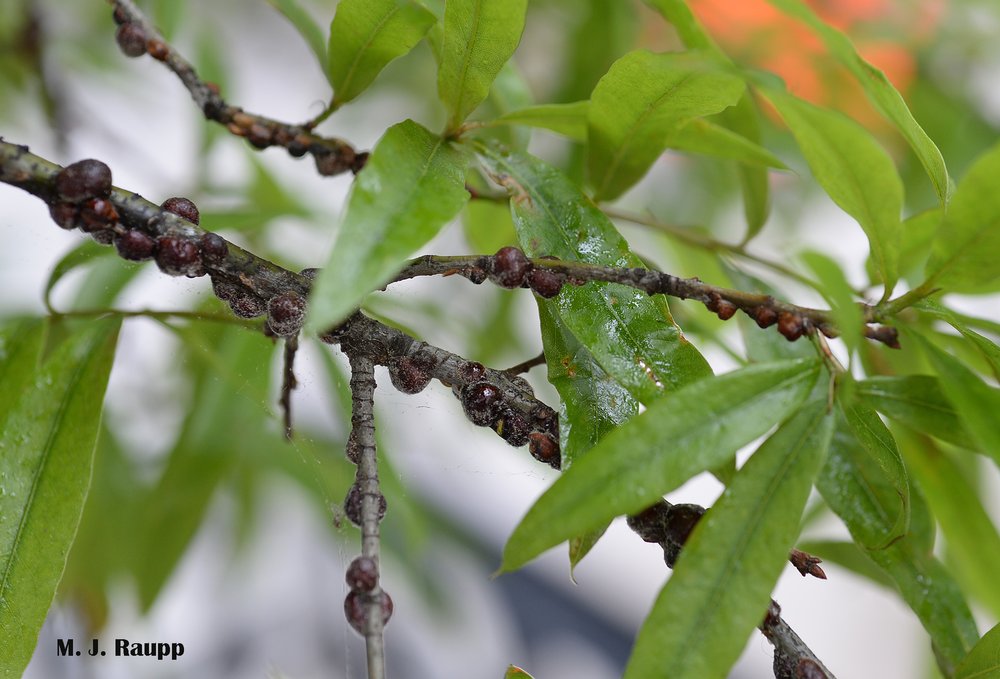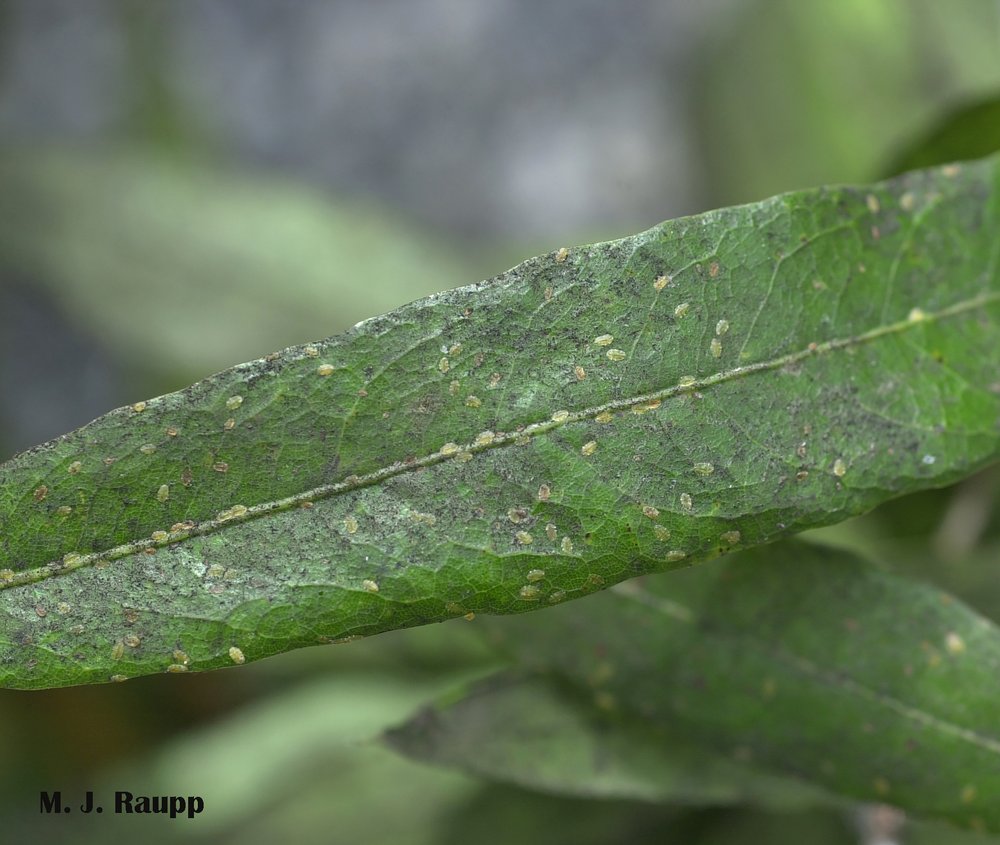Bumpy, sticky times for oaks in cities: Oak lecanium scale, Parthenolecanium quercifex

Brown bumps lining branches of oak trees are the bloated bodies of scale insects that suck vital sap from trees. They excrete a sticky sugar-rich liquid called honeydew. Honeydew fouls leaves and objects beneath the tree and attracts stinging insects.
Due to the abundance of buildings, streets, and other human-made infrastructure, cities usually support a much lower diversity of plants and animals than surrounding natural areas. However, some species have adapted quite well to city life and may actually thrive and become more abundant in cities than in surrounding suburbs or natural areas. In previous episodes we met bloodthirsty Culex mosquitoes that had taken up residence in subterranean pools beneath buildings in the nation’s capital, and red-shouldered bugs living the easy life dining on seeds of golden rain trees in Washington DC. This week we return to the city to discover another urban adapter enjoying life in the realm of concrete.

Oaks provide shade and beauty to city streets but are sometimes plagued by insect pests, diseases, and environmental stress.
Pin oaks, Quercus palustris, and willow oaks, Quercus phellos, are two grand native trees often planted in cities throughout much of the eastern United States. These beauties deliver a bonanza of ecosystem services including sequestering carbon, mitigating pollution, enhancing water infiltration by slowing rainfall, cooling (shading streets, sidewalks, buildings, yards), providing food for wildlife in the form of caterpillars for birds and nuts for squirrels, and just looking marvelous with summer greens and autumn russets. Ah, but as I roamed the streets of DC, I noticed oaks young and old with withered twigs, misshapen anemic leaves, some with coats of black fungus, and branches festooned with small brown bumps. These symptoms of misery are the handiwork of herbivorous insects known as scale insects.
Scale insects belong to a large group of insects called Hemiptera. They are characterized by having only three life stages – egg, nymph, and adult, in contrast to some of our more familiar insects like butterflies and bees that have four life stages – egg, larvae, pupa, and adult. In addition to this life stage difference, scale insects and other Hemiptera have sucking mouthparts used to sip fluids from plants. By contrast, caterpillars and beetles have jaws to munch leaves. The rascal waging war on the city oaks is a native pest called the oak lecanium scale. Nymphs and adults stick soda-straw-like mouth parts into a vascular tissue in leaves and stems called phloem. A tiny pump in their head allows them to suck nutrient-rich phloem sap into their bodies where it is used for growth and development and, in the case of females, production of eggs. Their feeding robs the oaks of nutrients, thereby reducing growth of branches and normal development and function of leaves.
Oak trees lining city streets are sometimes plagued by sap-feeding insects called soft scales. Colonies of mature, bump-like female scales line branches, sucking sap and excreting a sticky waste product called honeydew. Females can produce more than 1000 eggs which hatch into offspring called crawlers. Crawlers migrate from branches to leaves in spring, feeding and robbing trees of vital fluids. In autumn before leaf-fall, they move back to branches to pass the winter before maturing into adults next spring.

Immature scale insects suck sap from oak leaves in spring, summer, and autumn. They excrete honeydew, which serves as a substrate for the growth of a dark fungus called sooty mold.
An additional insult comes when excess fluids are discharged from the rear end of the scale insect in the form of a waste product called honeydew. We met another prodigious honeydew producer, spotted lanternfly, in a previous episode. Sugar-rich honeydew provides a substrate for the growth of an ugly black fungus called sooty mold that disfigures leaves, bark, and objects below the scale-infested tree. Unfortunately, honeydew also attracts stinging honeybees, yellow jackets, and paper wasps, creating a nuisance and health risk to people and pets.
Let’s circle back to the question as to why oak lecanium scales are more abundant in cities than in surrounding suburban and rural locations. The keys to these differences are found in a lack of scale-killing predators and parasitoids in cities and the warmer temperatures of cities, the phenomenon known as the urban heat island. Due to the predominance of buildings and hardscape, cities can be anywhere from a few degrees to more than ten degrees warmer than surrounding countryside. In a series of fascinating studies, entomologists at North Carolina State found oak lecanium scales to be 8 – 12 times more abundant on hotter urban trees. The abundance of egg-filled sacs was about five times greater on oak trees in hot spots than on trees in cooler locations. At warmer temperatures, survival of tiny scale nymphs was 20% greater than at cooler temperatures. Warm temperatures in the city may allow rapidly developing female scales to lay eggs before tiny parasitic wasps terminate their reproductive shenanigans. All in all, oaks and many other trees that line our streets and shade our parks have a tough go of it in the thermal refuge of a city. In many ways warmer temperatures of cities mimic larger changes associated with global climate change and a warming world. Scientists warn that if urban heat islands are the bellweather for a warming world, many of our pests may enjoy a heyday, not only in cities but in previously cooler parts of our land.
Acknowledgements
Two fantastic references, “Urban Warming Drives Insect Pest Abundance on Street Trees” by Emily K. Meineke, Robert R. Dunn, Joseph O. Sexton, and Steven D. Frank, and “Can Cities Activate Sleeper Species and Predict Future Forest Pests? A Case Study of Scale Insects” by Steven D. Frank and Michael G. Just were used to prepare this article.
This post appeared first on Bug of the Week